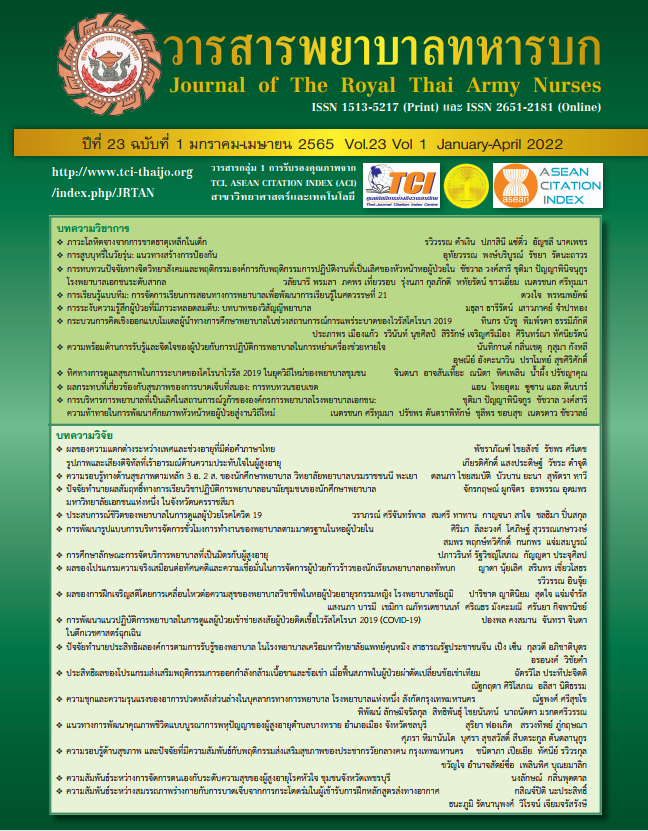The Effect of Gender and Age range Differences in older people on The Emotional Valence of Thai Words, Picture and Digitized Sounds
Keywords:
Emotional Valence, Thai Word, Picture, Digitized Sound, The older peopleAbstract
The purposes of this research were to design experimental activities of looking at Thai words, image and listening to digitized sounds which stimulated emotional valence of the older people and study the emotional, behavioral impression while looking at Thai words Pictures and listen to the digital sound that evokes the impression of being classified by gender and age range. The sample were older people living in Nong Suea district community, Pathumthani Province, 80 people. The instruments used in this research consisted of the activities of looking at Thai words, Picture and listening to digitized sounds which consisted emotional valence, Self-Assessment Manikin (SAM) The data were analyzed by Two-Way ANOVA.
The research results were as follows: 1. The activities of looking at Thai words, Picture and listening to digitized sounds consisted of 3 blocks; each block of 10 stimulus which were Everyday life, Nature view and the characteristics of art and culture Thai words Pictures and listen to the digital sounds. 2. The gender differences of the older people had no influence on looking at Thai words, Picture and listening to digitized sounds. 3. The early old age showed Daily life and the characteristics of art and culture more than middle old age with satistically significant at .05 level. It may be concluded that there was emotional valence; satisfied difference while older people with different Age range were looking at Thai words, image and listening to digitized sounds on emotional valence; satisfied. Suggestion This study should be conducted in conjunction with Event Related Potential. This is a deep study of how the brain functions and changes the EEG.
Downloads
References
Chewasopit W. Aging Society: The Changed Marketing Factor. Journal of MCU Nakhondhat 2019; 6(1): 38-54. (in Thai)
World Health Organization. Risk reduction of cognitive decline and dementia: WHO guidelines. Geneva: World Health Organization; 2019.
Puengsema R. Nursing Role in Caring for Persons with Dementia. Journal of Thai Red Cross Nursing 2020; 13(1): 15-24. (in Thai)
Sriworakul W, Srinualnad P, Sukhonthachit P, Chaiphibalsarisdi P & Huddleston D. Screening for Dementia in Elderly, Mae Chaem District, Chiang Mai Province. Journal of The Royal Thai Army Nurses 2020; 21(3), 243-251. (in Thai)
Kret, M., & De Gelde, B. A review on sex differences in processing emotional signals. Neuropsychologia 2012; 50(7), 1211-21.
Soares, A.P., Pinheiro, A.P., Costa, A., Comesana, M., & Pureza, R. Affective auditory stimuli: Adaptation of the international affective digitized sounds (IADS-2) for European Portuguese. Behavior Research Methods 2013; 45(4), 1168-1181.
Imbir, K., & Gołab, M. Affective reactions to music: norms for 120 excerpts of modern and classical music. Psychology of Music, Online first. (IF:2.01) 2016.
Whittle, S., Yucel, M., Yap, M. B., & Allen, N. B. Sex differnces in the neural correlates of emotion: Evidence from neuroimaging. Biologicol Psychology 2011; 87(3), 319-333.
Yao Z., Yu D., Wang L., Zhu X., Guo, J., & Wang, Z. Effects of Valence and Arousal on Emotional Word Processing Are Modulated by Concreteness: Behavioral and ERP Evidence From a Lexical Decision Task. Int J Psychophysiol 2016; 110(4), 231-242.
Ahveninen, J., Chang, W.T., Huang, S., Keil, B., Kopco, N., Rossi, S., Bonmassar, G., Witzel, T., & Polimeni, J. R. Intracortical depth analyses of frequency-sensitive regions of human auditory cortex using 7TfMRI. Neuroimage 2016; 143(12), 116-127.
Sripornngam T, Chadcham S & M.R. Sudhasan S. Development of the Thai Affective Picture Bank System. Research Methodology & Cognitive Science 2015; 13(2). 57-70. (in Thai)
Poosuwan T, Chadcham S & Thepsatitporn S. Development of the Affective Digitized Bank System in Thai Society. Research Methodology & Cognitive Science 2019; 16(2). 126-144. (in Thai)
Ngamprom C, Chadcham S & Wongupparaj.P. Development of the Affective Norms for Thai Words (THAI-ANW) Bank System. Research Methodology & Cognitive Science 2019; 15(2). 162-178. (in Thai)
Chaiyasung P, Chadcham S, Wongupparaj.P, Panthong K. The Effect of Gender and Personality Differences on Young Adults on The Emotional Valence of Thai Words and Digitized Sounds. Journal of Nursing and Education 2018; 11(4). 66-80. (in Thai)
Somdet Chaopraya institute of Psychiatry Memory Training Program for Dementia with BPSD. Nonthaburi: Department of Mental Health, Minstry of Public Health, 2013. (in Thai)
Edmonds, W. A., & Kennedy, T. D. An Applied Guide to Research Designs: Quantitative, Qualitative, and Mixed Methods (2nded.). California: Sage Publications, 2017.
Bradley, M.M. & Lang, P.J. Measuring Emotion: the Self-assessment Manikin and the Semantic Differential. Journal of Behavior Therapy and Experimental Psychiatry 1994; 25 (1). 83-93.
Desmet, P. M. A., Hekkert, P., & Jacobs, J. J. When a car makes you smile: Development and application of an instrument to measure product emotions. Advances in Consumer Research, 2000; 27, 111-117.
Luo, P., Zheng, X., Chen, X., Li, Y., Wang, J., Deng, L., & Zheng, X. Sex differences in affective response to different intensity of emotionally negative stimuli: An event-related potentials study. Neuroscience Letters, 2016; 578(2), 85-89.
Sakaki, M., Niki, K., & Mather, M. Beyond arousal and valence: The importance of the biological versus social relevance of emotional stimuli. Cognitive Affective and Behavioral Neuroscience, 2012; 12(1), 115-139.
Choi, Y., Lee, S., Jung, S., Choi, I. M., Park, Y. K., & Kim, C. Development of an auditory emotion recognition function using psychoacoustic parameters based on the International Affective Digitized Sounds. Behavior Research Methods, 2015; 47(4), 1076-1084.
Suwun A. & TakulsentiChok S. Prevalence and Factors Associated with Dementia among Elderly in Lukhok Subdistrict, Muang District, Pathumtani Province. APHEIT International Jourrna, 2016; 5(2), 21-32. (in Thai)
Chen, l., Wu, Y., Huang, C., Liu, L., Hwang, A., Peng, L., Lin, M., & Chen, L. Predictive factors for dementia and cognitive impairment among residents living in the veterans’ retirement communities in Taiwan: Implications for cognitive health promotion activities. Geriatrics Gerontology International 2017, 17(Suppl.1), 7–13.
Wanitchakham A. Preparation for Aging Society: A Case Study of Sai Mai District, Bangkok. Association of Private higher education institutions of Thailand under the patronage of her royal highness mahachakri Sirindhorn, 2020; 25(1), 164-179. (in Thai)
Wiles, J. L. & Jayasinha, R. Care for place: The contributions older people make to their communities. Journal of Aging Studies, 2013; 27(2), 93-101.
The Technical Promotion and Support Offices 1-12. The Suitable Welfare for The Elderly in Different Ages, Songkhla, 2556; The Technical Promotion and Support Offices 1-12. (in Thai)
Downloads
Published
How to Cite
Issue
Section
License
Copyright (c) 2022 Journal of The Royal Thai Army Nurses

This work is licensed under a Creative Commons Attribution-NonCommercial 4.0 International License.
บทความหรือข้อคิดเห็นใดใดที่ปรากฏในวารสารพยาบาลทหารบกเป็นวรรณกรรมของผู้เขียน ซึ่งบรรณาธิการหรือสมาคมพยาบาลทหารบก ไม่จำเป็นต้องเห็นด้วย
บทความที่ได้รับการตีพิมพ์เป็นลิขสิทธิ์ของวารสารพยาบาลทหารบก
The ideas and opinions expressed in the Journal of The Royal Thai Army Nurses are those of the authors and not necessarily those
of the editor or Royal Thai Army Nurses Association.






